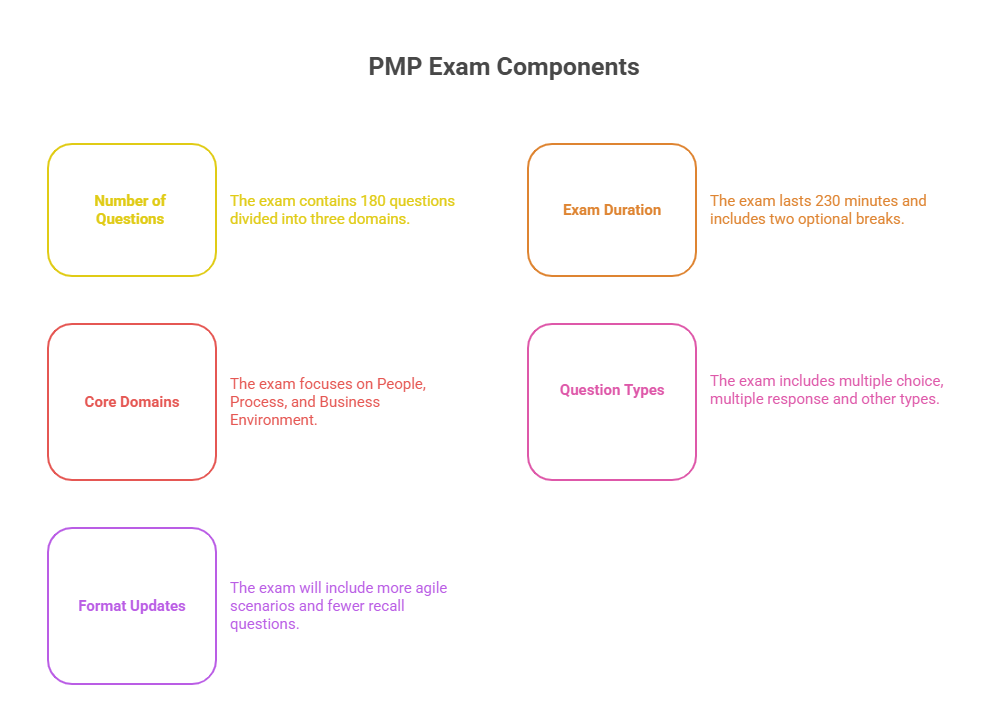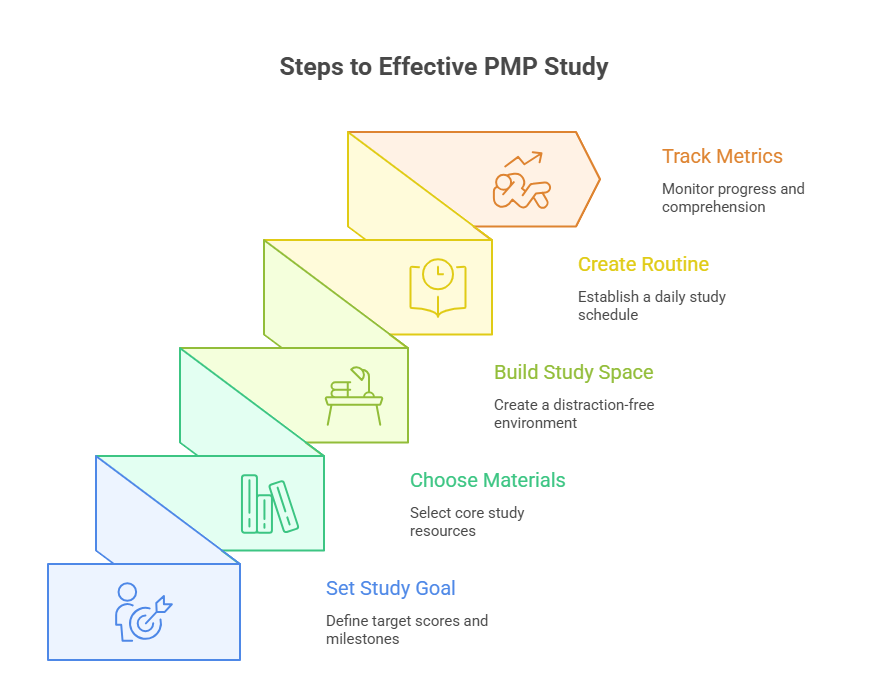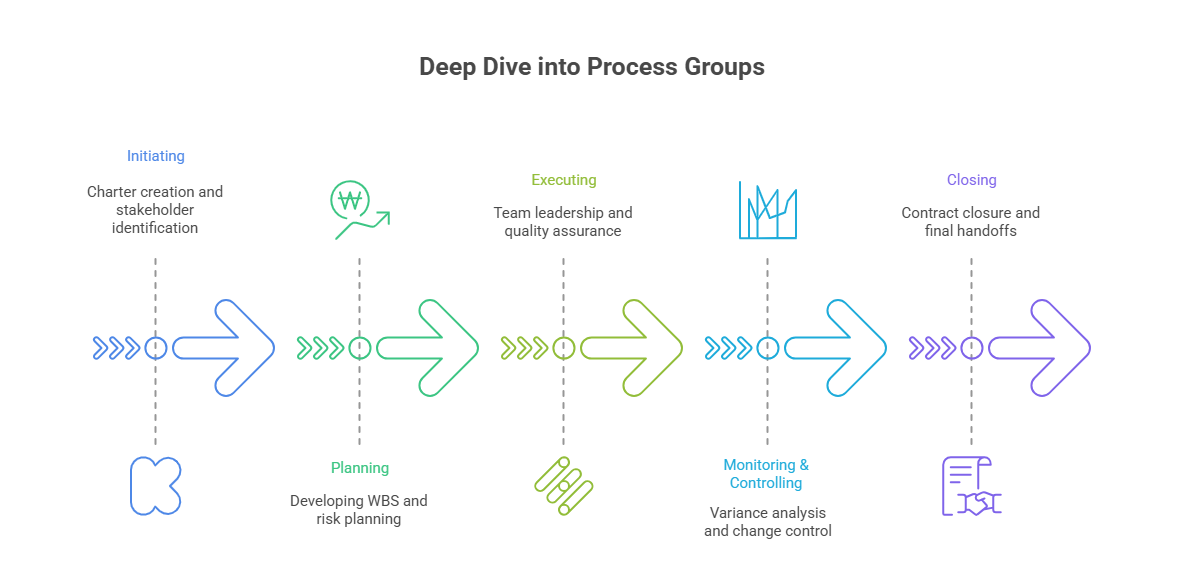30-Day PMP Exam Study Plan: Step-by-Step Expert Guide
Preparing for the Project Management Professional (PMP) exam in just 30 days demands a precisely engineered study strategy—not guesswork. With over 1 million active PMP holders globally, standing out in today’s fast-moving project landscape means acing one of the most rigorous certification exams in the industry. The key? A study plan that balances PMBOK mastery, simulation testing, and mental readiness, all within a tight timeline.
This guide delivers a zero-fluff, week-by-week roadmap to help you absorb core concepts, reinforce them through high-yield practice, and walk into test day with confidence. Whether you're balancing full-time work or shifting careers, this 30-day sprint is built to maximize retention, minimize overwhelm, and align with the 2025 PMP exam updates. Let’s dive in.
Understanding the PMP Exam Landscape
Acing the PMP isn’t just about memorizing terminology—it’s about mastering real-world application of project management principles under pressure. The PMP certification, governed by the Project Management Institute (PMI), is globally recognized for its comprehensive evaluation of leadership, strategy, and agile thinking across multiple industries. Understanding the exam structure, content focus, and evolution is critical for crafting an effective study gameplan.
Format, Domains & 2025 Updates
As of 2025, the PMP exam remains a 180-question, 230-minute assessment divided into three core domains: People (42%), Process (50%), and Business Environment (8%). These domains reflect the PMI Talent Triangle and integrate both predictive (waterfall) and adaptive (agile/hybrid) methodologies. The structure is designed not just to test theory, but how you apply frameworks like risk management, stakeholder engagement, and change control under varying scenarios.
You’ll encounter two scheduled breaks and face a non-linear navigation system, allowing flagged questions to be revisited. Exam delivery is available both online and at authorized testing centers.
The 2025 PMP update has continued PMI’s push toward realistic situational judgment, especially around agile practices. Expect deeper scenario-based analysis rather than purely definitional queries. Case-driven items might reference project team dynamics, hybrid workflows, or change resistance tactics. Furthermore, PMI’s Exam Content Outline (ECO) has emphasized ethical leadership and value delivery—core competencies tied directly to current industry demands.
To prepare smartly, align your study sessions with this evolving structure. Focus not just on memorization, but strategic reasoning using real-world project examples. Every hour spent mapping PMI’s blueprint to your study content reduces the chance of surprises on test day.
Types of Questions to Expect
The PMP exam tests far more than textbook definitions—it evaluates strategic thinking, decision-making, and situational leadership. While question formats vary, they are crafted to mimic challenges project managers face on the ground.
Here’s what you’ll face:
Multiple Choice (MCQ): Still the dominant format. These often include subtle distractors, requiring nuanced understanding of both PMBOK 7th Edition and real-world context.
Multiple Response: Choose more than one correct option. These test your ability to differentiate overlapping concepts, especially in agile ceremonies or planning processes.
Matching & Hotspot: You may match process stages to tasks or highlight areas within charts or diagrams. These reinforce visual literacy and process flow comprehension.
Drag and Drop Scenarios: Often used to sequence events across project life cycles, particularly useful for hybrid methodology assessments.
Situational Judgment Questions (SJQ): A major portion of the exam, these present leadership conflicts, ethical dilemmas, or resource trade-offs. They demand alignment with PMI’s Code of Ethics and a deep grasp of stakeholder management.
Don’t expect straightforward recall questions. Instead, PMI aims to simulate the pressures of project environments, testing how well you manage ambiguity, stakeholder conflict, and cross-functional priorities under constraint.
Week 1: Laying the Groundwork
The first week isn’t about rushing into memorization—it’s about engineering your study environment and mental framework for success. Establishing strong foundations during Week 1 increases retention, reduces burnout, and ensures you’re not reacting to the PMP exam—you're anticipating it. From selecting resources to designing a high-yield study schedule, your prep begins with precision.
Setting Goals and Gathering Materials
Start by defining a clear outcome-based goal for the 30-day timeline. “Passing the PMP” is not enough—your goal should be measurable: Score 80%+ on all mocks by Day 25. This focus turns daily tasks into deliberate milestones.
Next, lock in your primary study resources. The top three include:
PMBOK® Guide – 7th Edition for foundational concepts
Agile Practice Guide for hybrid and adaptive workflows
Third-party prep tools like Rita Mulcahy’s PMP Exam Prep or PM PrepCast
For practice questions and mock exams, choose platforms that mimic the real Pearson VUE environment with question diversity and performance analytics. Pair this with digital flashcards and a simple error log to record missteps and reinforce weak areas.
Create a distraction-free workspace and structure your week with non-negotiable daily study blocks. Use digital calendars or timeboxing to maintain consistency. Every day, aim to absorb a process group concept, practice 15–20 questions, and spend 15 minutes reviewing past errors.
Lastly, set up progress checkpoints every 3–4 days to recalibrate. A great early metric? Consistently scoring 60–65% on basic topic quizzes by Day 5 means you’re absorbing effectively.
Structuring Daily Study Blocks
Your cognitive stamina matters more than sheer study hours. Instead of marathon sessions, focus on deep, distraction-free blocks—ideally 2 to 3 hours per day, divided into 40–50-minute Pomodoro segments with short breaks in between.
Here’s a sample daily structure:
30 min: Active reading (e.g., PMBOK or Agile Practice Guide)
40 min: Practice questions (mixed topic sets)
20 min: Review and correct missed items
15 min: Flashcards or visual concept mapping
15 min: Agile or hybrid concept drill
Rotate topics to maintain engagement. Avoid passive reading—interact with material using note-taking techniques like Cornell method or Feynman technique for better retention. If energy is low, switch to watching a high-yield PMP video (like David McLachlan or Aileen Ellis) to stay in rhythm without fatigue.
Ensure Sundays serve as mini diagnostic checkpoints. Take a short 30–40 question quiz, evaluate time-per-question, and adjust pacing if needed. The focus of Week 1 isn’t volume—it’s building a system you can scale in Week 2 and 3 with zero confusion and complete consistency.
Week 2: Deep Dive into Process Groups
This is the week where technical clarity meets practical application. Instead of memorizing isolated terms, you’ll embed yourself into PMI’s process logic—understanding how each phase flows, feeds, and builds upon the others. Mastery of the five process groups is non-negotiable. This week ensures your foundation becomes operational knowledge, ready for scenario-based questions.
Initiating, Planning, Executing
Initiating sets the tone. Understand why project charters, business cases, and stakeholder registers are foundational. Study tools like Power/Interest grids and stakeholder analysis matrices—these frequently appear in PMP situational items. Visualize how a sponsor authorizes a project and how a project manager translates that into strategic alignment.
Move to Planning—the most question-heavy area. Focus on the integration of subsidiary plans (scope, schedule, cost, risk, procurement, and stakeholder engagement). Learn how outputs interconnect. For example, how risk responses impact cost and schedule baselines.
Prioritize planning tools like:
PERT estimation and Critical Path Method (CPM)
Earned Value Management (EVM) formulas and thresholds
Requirements traceability matrices
In Executing, dive into team performance, quality assurance, communication execution, and procurement implementation. This is where leadership soft skills and technical discipline collide. Expect questions around change implementation, conflict resolution, and managing vendor relationships.
Build situational awareness by solving questions that cross domains—e.g., How does a scope creep during execution affect risk response and stakeholder communication plans? This kind of synthesis will define your ability to score above 80%.
Monitoring, Controlling & Closing
Start with Monitoring and Controlling, where oversight becomes an art form. These questions often test your ability to identify corrective actions, preventive measures, and when to issue change requests. Study:
Control limits vs. specification limits
Integrated change control processes
Variance analysis techniques (CPI, SPI)
Use visual tools like control charts and Gantt overlays to strengthen your interpretation of performance data. PMI expects you to know not just the numbers, but what the numbers mean for real-time project decisions.
Closing is brief but exam-critical. You may face 1–2 questions specifically about lessons learned, formal sign-off, or final procurements. Master:
Project vs. phase closure
Final documentation archiving
Transitioning deliverables to operations
Treat this group as a final test of your ability to think full-lifecycle. PMI favors candidates who see the project beyond execution—ensuring value delivery even after the team disbands.
To reinforce retention, use cumulative review methods: map a real or hypothetical project through all five groups, identifying tools, outputs, and decisions made in each phase. By Week 2’s end, you’re no longer just a student—you’re thinking like a PMP.
Week 3: Mock Tests and Gap-Filling
This week is about stress-testing your knowledge under exam-like pressure. Passive review won’t cut it anymore—your focus now shifts to mock exams, time management, and data-driven revision. By simulating the full exam environment and diagnosing weak spots, you transform knowledge into exam readiness.
Simulating Exam Conditions
Begin by scheduling at least two full-length PMP mock exams this week—ideally on Day 16 and Day 20. Use reputable platforms like PM PrepCast, EduHubSpot, or Simplilearn that mirror the Pearson VUE interface. The simulation must replicate:
180 questions
230-minute limit
Two 10-minute breaks
Non-linear navigation (flag and return)
Replicate real test conditions: no interruptions, timed breaks, and no external reference material. Wear headphones if you plan to take the actual test online. The goal is to condition your brain for sustained focus and strategic pacing.
After the mock, immediately analyze:
Time per question
Percent accuracy by domain
Performance across question types (situational, agile, formula-based)
Use this data to adjust your pacing. If you’re consistently exceeding 1.5 minutes per question, drill time-boxed practice sets (20 questions in 30 minutes) to retrain decision speed.
Also, track your confidence-to-correctness ratio. If you’re getting answers right but second-guessing yourself, build certainty. If you’re confident but consistently wrong in certain domains, it’s a red flag for conceptual misunderstanding.
Targeted Review of Weak Areas
With diagnostic data in hand, enter gap-filling mode. Rank your weakest domains from mock tests and create a rotation matrix: spend 70% of your study time on low-scoring areas, 20% on medium, and 10% on strengths (to avoid attrition).
Example gap-filling strategies:
Low “People” score? Rewatch stakeholder videos and role-play conflict scenarios
Struggling in “Process”? Build end-to-end process maps using mind-mapping tools
Missed Agile items? Revisit Scrum and Kanban events, roles, and artifacts using Agile Practice Guide
Focus on active correction over passive reading. Use “learn by teaching” tactics—explain a misunderstood topic aloud, or record yourself walking through an EVM problem. Fill an error log with every missed question and annotate it with root cause (knowledge gap, trick question, misread scenario).
Don’t ignore pattern-based errors: if you're consistently missing ethics and leadership questions, it’s often a mindset disconnect, not a knowledge issue. Review PMI’s Code of Ethics and roleplay what a servant leader or change advocate would do in tricky scenarios.
Finally, set a mini mock on Day 21—60 questions in 75 minutes. Score >75%? You’re on track. Score below? Extend gap-filling through Day 23.
| Activity | Purpose & Execution |
|---|---|
| Full-Length Mock Exams | Take at least two full-length PMP mock exams (Day 16 & Day 20) under real conditions. Use platforms that simulate the Pearson VUE interface with timed sections and flagging options. |
| Performance Diagnostics | After each mock, break down results by domain, time per question, and question type. Identify weak areas and recurring errors using performance analytics and error logs. |
| Error Log Creation | Maintain a detailed error log of every incorrect answer. Include the question type, your chosen answer, the correct one, and the rationale. Use this log daily for targeted revision. |
| Gap-Focused Reviews | Spend 70% of your study time on lowest-performing domains. Use flashcards, mind maps, and recorded video explanations to reinforce difficult concepts. |
| Mini Mock (Day 21) | Take a 60-question mini mock under timed conditions. Target >75% to confirm readiness. If below, intensify gap-repair efforts through Day 23 using active recall techniques. |
Week 4: Final Review and Mindset Prep
This final stretch is about precision, mindset, and reinforcement. The heavy lifting is done—now, you tighten loose ends, revisit volatile content, and enter the exam with strategic calm. The goal this week is not to cram, but to consolidate, rehearse, and stabilize your knowledge base so test day feels like a formality, not a fight.
Revisiting Agile and Hybrid Questions
Agile and hybrid methodology now dominate the PMP exam landscape, often making up nearly 50% of situational questions. Even if your background is in traditional project management, this is not optional review—you must treat Agile mastery as essential.
Revisit core Agile principles:
12 Agile Manifesto Principles
Scrum roles (PO, SM, Dev Team) and ceremonies (sprint planning, retrospectives, reviews)
Kanban flow metrics like WIP limits and lead time
Reinforce the difference between Agile, Iterative, Incremental, and Hybrid approaches. PMI loves testing subtle distinctions, such as when a hybrid model makes more sense than pure Agile, especially in compliance-heavy projects or legacy system integration.
Use visual tools like Venn diagrams or process timelines to map hybrid workflows. Focus particularly on:
Stakeholder involvement cadence
Documentation balance
Change responsiveness vs. scope lock
Practice 40–50 Agile questions back-to-back, identifying recurring logic patterns. Don’t just memorize answers—break down the PMI reasoning behind them. This cements conceptual agility, a trait they’re explicitly testing for.
Test Day Strategies and Confidence Tips
With knowledge stabilized, now shift focus to performance psychology. The PMP exam rewards calm under ambiguity—not panic under pressure. Your mindset on test day will determine how effectively you retrieve and apply everything you’ve studied.
Tactical prep:
Final full mock test on Day 26. Do not take any full-length test after that.
Day 27–28: Light review only. Focus on your error log, Agile refreshers, and watching brief recap videos.
Day 29: Close your books by 6 p.m. No late-night cramming.
Day 30: PMP exam day.
Practical test day checklist:
Double-check Pearson VUE check-in procedures (ID, system readiness)
Prepare a quiet room, clean desk, and test-ready laptop (for online exam)
Take your 10-minute breaks—hydrate, stretch, avoid screens
Mental calibration tips:
Use deep breathing techniques before and during the test to regulate adrenaline
Answer each question decisively—don’t dwell longer than 90 seconds
Flag uncertain questions and circle back with fresh eyes
Most importantly, trust your prep. You’ve spent four weeks becoming fluent in PMI’s logic. Now it’s about execution. Walk in not hoping to pass, but knowing you're trained to.
| Task | Execution Strategy |
|---|---|
| Agile & Hybrid Refresh | Review Agile Manifesto principles, Scrum roles/events, Kanban flow, and hybrid methodology comparisons. Use 40–50 question drills focused purely on Agile and hybrid scenarios to refine understanding. |
| Mock Exam (Day 26) | Take your final full-length mock exam under real test conditions. Analyze domain-wise performance and pacing. Avoid taking any more full exams after this point to reduce cognitive fatigue. |
| Knowledge Tapering | Use Days 27–28 for flashcards, brief video refreshers, and reviewing your error log. No new content should be introduced. Focus shifts to reinforcing already-learned material with light repetition. |
| Test Day Preparation | Verify Pearson VUE login, system compatibility, and check-in procedures. Prepare a clean desk setup for the online test. Get adequate sleep and hydrate well the night before. |
| Mindset & Confidence Building | Practice breathing exercises, positive visualization, and mental rehearsal of the exam experience. Remind yourself of your progress using your mock exam scores and progress logs. |
How APMIC’s Certification Program Supports PMP Success
The PMP exam doesn’t just test memory—it demands strategic fluency, exam discipline, and scenario-based decision-making. That’s why the APMIC Advanced Project Management Certification is structured as more than just a course—it's a full-stack training system specifically engineered to help you pass the PMP exam with confidence. If you’re preparing for PMP exam within a 30-day timeframe, this program offers an enormous advantage through targeted learning, CPD credits, and elite simulation support.
Curriculum Overview, CPD Hours, and Simulation Practice
APMIC’s curriculum spans 542+ project management modules, each aligned with PMI’s evolving exam blueprint. That includes detailed lessons on:
All five process groups and ten knowledge areas
Predictive, agile, and hybrid workflows
Risk, scope, cost, and schedule integration
Stakeholder, procurement, and communication mastery
Each module includes scenario walkthroughs, formula-based examples, and domain-level drills that mimic PMP exam logic. The program delivers over 120 CPD-accredited hours, meeting and exceeding PMI’s contact-hour requirements and preparing you for long-term career advancement beyond the exam.
But where APMIC stands apart is in its mock testing and performance diagnostics. The certification includes multiple full-length PMP-style simulations, each with analytics that track:
Time-per-question breakdown
Confidence scoring vs. accuracy
Domain-level performance variance
These reports allow you to customize your gap-filling week with laser precision. No more guessing where to focus—you’ll have data to guide your every move.
Get PMP-Ready with APMIC’s Certification Program
If you're ready to turn a 30-day timeline into a guaranteed transformation, the APMIC Advanced Project Management Certification is your tactical edge. The program is self-paced, mobile-accessible, and built specifically for working professionals who need flexibility and rigor combined.
Inside, you’ll gain access to:
Instant downloadable project templates for planning, risk, and stakeholder maps
Real-world case scenarios aligned with 2025 PMP exam situational formats
Access to faculty-led Q&A threads and certification mentor feedback
The best part? You can enroll today and start your study plan within 10 minutes, with all modules unlocked. Whether you're a first-time PMP candidate or a returning test-taker aiming for a top-tier score, APMIC’s certification program is built to deliver results.
Frequently Asked Questions
-
Passing the PMP exam in 30 days is challenging, but entirely possible with a structured, high-efficiency plan. It requires 2–3 hours of focused study daily, mock test simulations, and deep immersion into PMI's process logic. The exam tests scenario application, not memorization. You’ll need to balance time across People, Process, and Business Environment domains, while mastering both predictive and agile workflows. Using a data-driven approach—like mock diagnostics and an error log—can dramatically increase your odds of success. If your foundation is strong and you use the APMIC Advanced Project Management Certification, which includes simulations and CPD hours, you can pass confidently even on a tight schedule.
-
The most tested PMP topics include process group interactions, change control, stakeholder engagement, earned value management (EVM), agile ceremonies, and team conflict resolution. PMI heavily favors scenario-based questions that require judgment calls rather than definitions. Focus on mastering the integration of knowledge areas—how scope affects schedule, how risk alters cost, etc. Agile and hybrid frameworks make up nearly 50% of the exam, so familiarity with Scrum, Kanban, and hybrid strategies is essential. Leverage structured courses like APMIC’s PMP-aligned certification, which walk you through high-yield content and reinforce understanding through real-world cases and mock testing.
-
For a 30-day study window, aim to take at least three full-length mock exams. One should be around Day 16, one around Day 21, and one around Day 26. This ensures proper pacing, stress-testing, and performance diagnostics. Use platforms that simulate the Pearson VUE environment with question timers, flagging, and realistic domain distribution. After each mock, spend time breaking down your score by process group and question type. Track your weak areas using an error log. If you’re using a structured course like the APMIC Advanced Project Management Certification, it includes built-in mock exams that mimic the PMP’s structure, helping you rehearse under true conditions.
-
You must be proficient in both, but Agile and hybrid approaches now make up a significant portion of the exam—sometimes up to 50%. PMI wants candidates who can lead adaptive teams, especially in dynamic environments. You’ll see scenario questions that involve sprint planning, backlog refinement, stakeholder collaboration, and delivery increments. That said, predictive frameworks remain vital—particularly in planning, cost control, and procurement. The trick is understanding when to apply which methodology. Courses like the APMIC certification break down these nuances using hybrid case studies, allowing you to map methodology choices to specific project types.
-
Top mistakes include memorizing instead of understanding, underestimating the exam's situational nature, skipping performance diagnostics, and neglecting Agile content. Many also spend too much time on theory and not enough on solving timed questions. Others cram too late or ignore mindset prep entirely. Another major error is using outdated prep materials—PMBOK 6th edition only won't cut it anymore. Successful candidates take mock exams seriously, review their errors daily, and follow a guided framework like the APMIC certification, which includes live scenarios and simulation-based correction tools. Consistency, not cramming, is the ultimate differentiator.
-
Yes—the PMP exam in 2025 reflects the evolution of modern project management. With the increased focus on agile, hybrid models, and leadership behaviors, it's more dynamic and application-focused than ever. The exam now tests how you handle ambiguity, make decisions with limited data, and lead across cultures or virtual teams. The structure has become more behavioral and situational, moving away from purely formulaic or definitional questions. If you’re studying using materials that predate the 2021 update, you’ll be unprepared. Enrolling in an up-to-date course like the APMIC Advanced Project Management Certification ensures you’re aligned with the 2025 format.
-
For full-time professionals, the key is consistency over volume. Allocate 2–3 hours daily using deep-focus blocks—early mornings or post-dinner slots often work best. Use weekends for longer mock tests and detailed reviews. Follow a rotation:
Week 1: Foundations + materials setup
Week 2: Core process groups
Week 3: Full mock exams + gap-filling
Week 4: Agile, hybrid, and test-day prep
Leverage mobile flashcards, audio summaries, and Agile crash courses on commute or downtime. Programs like APMIC’s certification are built for flexibility, letting you access modules anytime across devices and compressing high-yield prep into manageable blocks.
Final Thoughts
Acing the PMP exam in just 30 days is no small feat—but with the right mindset, the right materials, and a surgical study plan, it's absolutely achievable. Every hour must be intentional. Every mock test must reveal a lesson. Every weakness must be seen as a pathway to improvement. The PMP isn't about memorizing; it’s about thinking like a project leader under real-world constraints.
The APMIC Advanced Project Management Certification exists to eliminate the guesswork. With CPD-accredited training, simulation-based feedback, and full-spectrum coverage of agile, hybrid, and predictive workflows, it’s built for professionals serious about passing—fast.
Start strong, finish focused, and walk into test day knowing you’ve trained for clarity, speed, and success. Your certification—and your career momentum—start now.
| Quick Poll: What's Your Biggest PMP Exam Challenge? | |
|---|---|
| Sticking to a consistent 30-day study schedule | |
| Mastering agile and hybrid methodologies | |
| Handling situational and scenario-based questions | |




